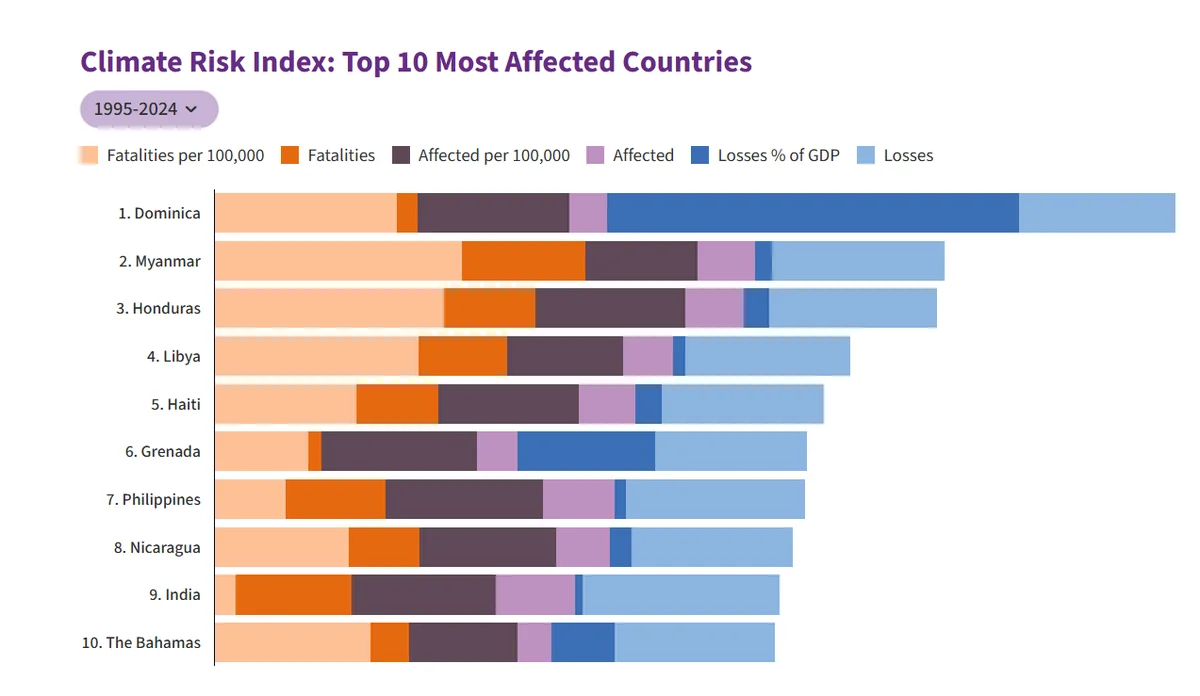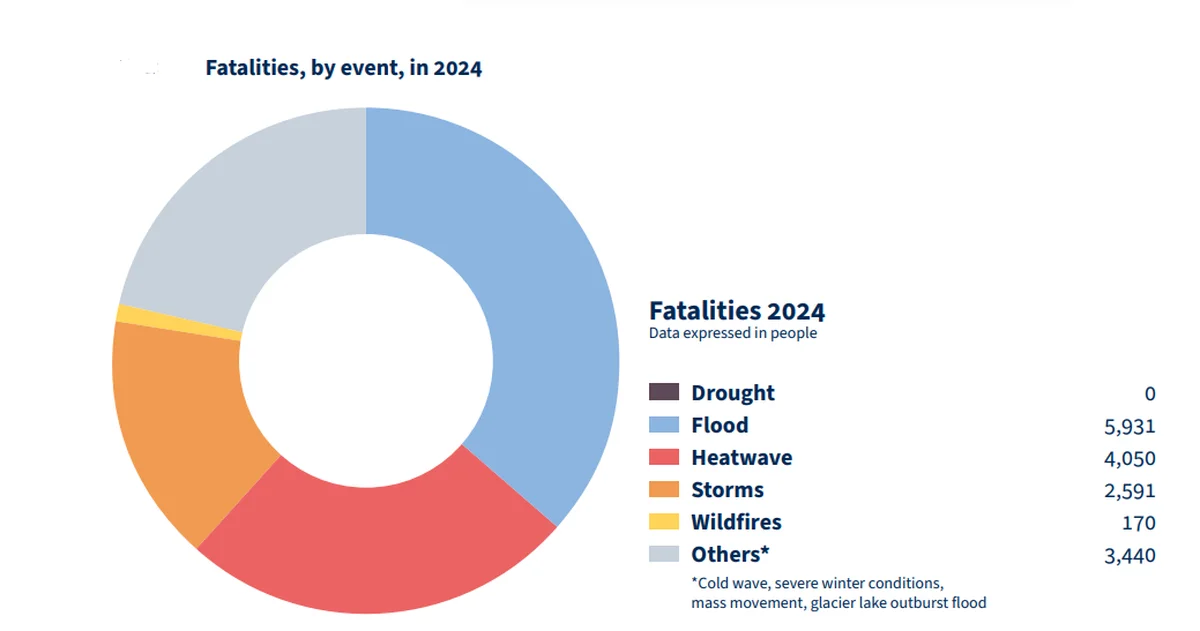Climate Risk Index (CRI) 2026 | 14 Nov 2025
For Prelims: Climate Risk Index, UNFCCC, Glacial Lake Outbursts, Ocean Acidification, Himalayan Glaciers, Arsenic Contamination, Black Carbon, Western Ghats, Mangroves, Coral Reefs, Cyclone, National Water Policy 2012, Traditional Water Systems, Green Hydrogen, Jal Sanchay Jan Bhagidari
For Mains: Key Findings of the Climate Risk Index (CRI) 2026 Report. global impact of Extreme Weather, Climate Change’s Threats to India, and Necessary Mitigation Measures
Why in News?
The Germanwatch Climate Risk Index 2026 report, presented at COP30 in Belém, Brazil, ranks India as the 9th most affected country by extreme weather events (EWEs) over the past three decades (1995-2024).
Climate Risk Index
- The Climate Risk Index, published annually by the environmental think tank Germanwatch since 2006, tracks the human and economic impacts of extreme weather events worldwide.
- Indicators: The index uses six key indicators, including fatalities, economic losses, and the number of people affected by climate-related disasters.
- Data for the index is sourced from reputable organizations like the EM-DAT International Disaster Database, World Bank, and IMF.
What are the Key Findings of the Climate Risk Index (CRI) 2026 Report?
- Globally Most Affected Countries: The top 10 CRI countries are all in the Global South, highlighting unequal climate vulnerability.
- High-risk countries like Dominica, Myanmar, Honduras, and Libya have faced extreme events, e.g., Cyclone Nargis (2008) in Myanmar killed around 1,40,000 people.
- Between 1995–2024, 9,700 extreme weather events worldwide caused over 832,000 deaths and USD 4.5 trillion in economic losses.
- India’s Vulnerability: India's position in the CRI 2026 emphasizes its growing vulnerability to climate-related disasters. In 2024, India ranked 15th among countries most affected by climate change.
- Over three decades, 430 extreme weather events (EWEs) caused USD 170 billion losses, affected 1 billion people, led to 80,000+ deaths, placing India under “continuous threats” with Philippines, Nicaragua, and Haiti.
- India ranked 3rd globally in 2024 for the number of people affected by extreme weather, after Bangladesh and the Philippines.
- Specific EWEs: In 2024, floods were the deadliest globally (~50 million affected), followed by heatwaves (~33 million) and droughts (~29 million); India’s monsoon adversely affected 8 million people.
- CRI ranks countries by extreme weather impacts, focusing on rapid onset events like floods, storms, heatwaves, wildfires, glacial lake outbursts, and excluding slow onset events such as rising temperatures, sea-level rise, and ocean acidification.
- Long-Term Vulnerability: Repeated disasters cause accumulating losses, keeping India’s 30-year CRI ranking high, as continuous exposure hinders recovery and raises long-term socio-economic risk.
What are the Impacts of Climate Change on India?
- Water Crisis:
- Melting Glaciers: Rising temperatures are shrinking Himalayan glaciers, threatening river flows of the Ganga, Brahmaputra, and Indus.
- Depleting Groundwater: Groundwater use rose from ~10–20 km³ to 240–260 km³ over 50 years; Gangetic aquifers are falling ~4 cm/year, making many perennial rivers seasonal.
- Water Quality Degradation: Groundwater pumping brings arsenic contamination, ranking India 120th of 122 countries on the global water quality index.
- Disruption in Mountain Ecosystems:
- Increased Disasters: Events like GLOFs (e.g., 2023 Sikkim disaster), cloudbursts, and forest fires are becoming more frequent.
- Accelerated Melting: Black carbon from vehicles and fossil fuel use, especially along the Char Dham route, speeds up Himalayan ice melt.
- Threat to Biodiversity: The Himalayas, one of India’s four biodiversity hotspots (with the Western Ghats, Sundaland, and Indo-Burma), face severe ecological stress.
- Threat to Coastal Areas:
- Rising Sea Levels: Global seas are rising 3.6 mm/year, with Mumbai seeing a 4.44 cm rise (1987–2021); projections show a 0.4–0.8 m rise by 2100, endangering coastal cities.
- Salinisation: Seawater intrusion is damaging farmland and freshwater, affecting over 250 million coastal residents.
- Loss of Natural Defenses: Mangroves and coral reefs, vital cyclone and erosion buffers, are increasingly at risk.
- Socio-Economic Costs:
- Economic Losses: The World Bank warns the climate crisis could cut India’s GDP by 6.4–10% by 2100 and push 50 million into poverty.
- Agricultural Distress: Erratic weather and water scarcity are lowering farm productivity and threatening food security.
- Public Health Risks: The urban heat-island effect heightens heat stress and health risks in densely populated slums.
What Measures should India Take to Address the Impacts of Climate Change?
- Climate Change Mitigation: Drastically cut emissions to limit warming to 1.5°C and extreme weather, support National Adaptation Plans, and secure USD 300 billion by 2035 for climate adaptation and mitigation.
- Securing Water Resources: India must renew its National Water Policy 2012 for sustainable aquifer management and climate-resilient farming using drip irrigation and zero-tillage, while reviving traditional water systems and scaling up artificial recharge through pits, shafts, and trenches.
- Build Coastal Resilience: Restore mangrove forests and coral reefs as natural barriers. Develop early-warning systems for cyclones and storm surges, and create social safety nets for affected communities.
- Decarbonize Economy: Ramp up solar and wind capacity to exceed 500 GW of non-fossil fuel power by 2030, while promoting green hydrogen and battery storage.
- Promote sustainable urbanization with green buildings, urban greenery, and permeable surfaces, while enforcing eco-friendly land-use policies to curb deforestation and ensure sustainability.
- Governance and Social Measures: Mainstream climate adaptation in all development planning, promote community-led resource management through participatory models like Jal Sanchay Jan Bhagidari, and boost green R&D in technologies, carbon capture, and resilient crops.
Conclusion
The CRI 2026 underscores India’s high vulnerability to extreme weather events and long-term climate risks, affecting water, ecosystems, coasts, and socio-economic stability. Urgent measures in adaptation, water management, coastal resilience, decarbonization, and sustainable governance are essential to mitigate impacts, protect livelihoods, and ensure climate-resilient development.
|
Drishti Mains Question: Examine the threats posed by global warming to India's Himalayan and coastal ecosystems. Suggest sustainable measures for building resilience in these regions. |
Frequently Asked Questions (FAQs)
1. What are the projected sea-level rise impacts for India?
Global sea level rose ~3.6 mm/yr (last decade); projections of 0.4–0.8 m by 2100 endanger coastal cities (Mumbai, Chennai, Kolkata) and ~250 million residents within 50 km of the coast.
2. What is the scale of India’s groundwater depletion?
Groundwater use rose from ~10–20 km³ to 240–260 km³ over 50 years; Gangetic aquifers are falling ~4 cm/year, making many perennial rivers seasonal.
3. According to the World Bank, how much could climate change reduce India’s GDP by 2100?
The World Bank estimates climate impacts could cut India’s GDP by 6.4–10% and push 50 million people into poverty by 2100.
UPSC Civil Services Examination, Previous Year Questions (PYQs)
Prelims
Q. Which of the following statements is/are correct about the deposits of ‘methane hydrate’? (2019)
- Global warming might trigger the release of methane gas from these deposits.
- Large deposits of ‘methane hydrate’ are found in Arctic Tundra and under the sea floor.
- Methane in atmosphere oxidizes to carbon dioxide after a decade or two.
Select the correct answer using the code given below.
(a) 1 and 2 only
(b) 2 and 3 only
(c) 1 and 3 only
(d) 1, 2 and 3
Ans: (d)
Q “Momentum for Change: Climate Neutral Now” is an initiative launched by (2018)
(a) The Intergovernmental Panel on Climate Change
(b) The UNEP Secretariat
(c) The UNFCCC Secretariat
(d) The World Meteorological Organisation
Ans: (c)
Mains
Q. ‘Climate change’ is a global problem. How India will be affected by climate change? How Himalayan and coastal states of India will be affected by climate change? (2017)


